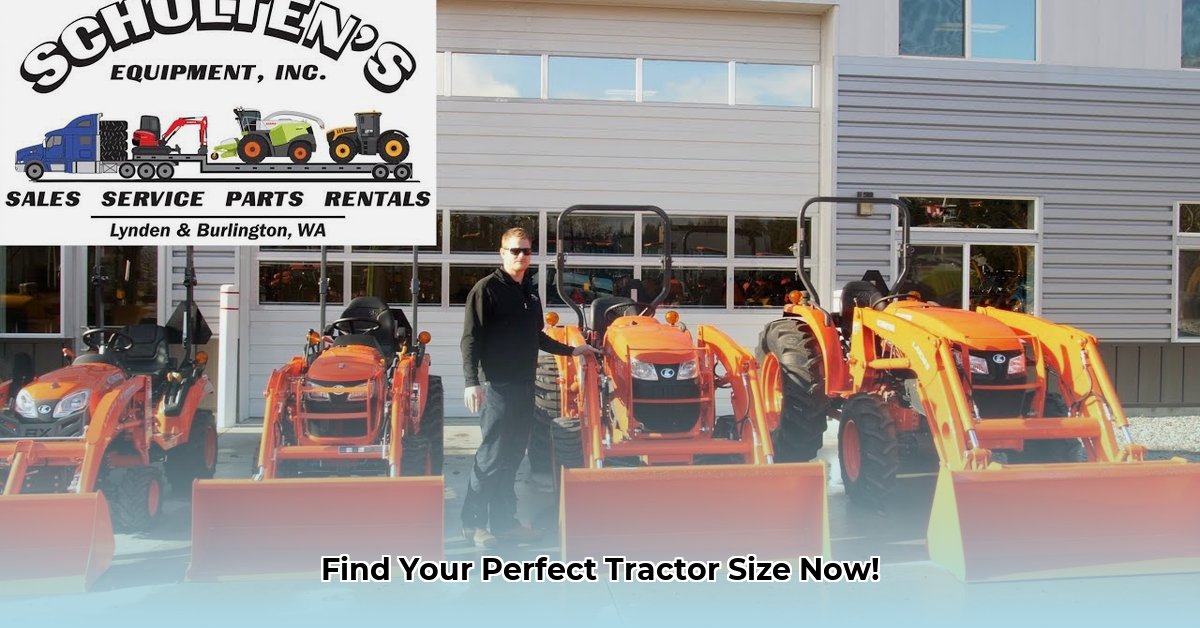
Sustainable farming practices demand careful consideration of every aspect of the operation, and tractor selection is no exception. Choosing the right tractor size is crucial for optimizing efficiency, minimizing environmental impact, and ensuring long-term profitability. This guide will help you navigate the complexities of tractor sizing for a sustainable future. Getting the right tractor ensures your farm thrives. For more detailed guidance, check out this helpful resource on tractor sizing.
Understanding Tractor Size and its Impact
Tractor size isn't just about horsepower (engine power). It's a complex interplay of horsepower, weight, and dimensions. A larger tractor offers greater power for quicker work on large fields, excelling in large-scale operations. However, this often comes with increased fuel consumption and heavier weight, leading to more soil compaction. Soil compaction negatively impacts soil health and can reduce crop yields over time. Would you rather have quicker work with a larger environmental impact, or slower work with a positive environmental impact?
Smaller tractors, conversely, are fuel-efficient and gentler on the soil, minimizing compaction and promoting healthy soil structure. They're more maneuverable in tighter spaces. But, completing the same amount of work takes longer, potentially increasing labor costs and time spent. The ideal size balances these factors, aligning perfectly with your farm's specific needs.
Assessing Your Farm's Needs: A Step-by-Step Guide
Before browsing tractor brochures, meticulously assess your farm's unique characteristics. This structured approach helps determine the optimal tractor size for your operation.
Step 1: Comprehensive Farm Profile: Detail your farming practices (conventional, no-till, organic), crop types, farm size (in acres), and typical field operations (plowing, planting, harvesting, spraying, etc.). The more detail you provide, the more accurate the assessment will be.
Step 2: Estimating Power Requirements: Determine the horsepower (hp) needed for each task. Many online calculators exist, but professional input from equipment dealers or experienced farmers can refine this estimate. Overestimating by 10-15% provides a crucial safety margin for unexpected challenges or heavier-than-anticipated soil conditions.
Step 3: Soil Type Analysis: Heavy clay soils require more power than lighter sandy soils. Matching tractor power to soil conditions prevents excessive compaction and maintains soil health.
Step 4: Budgetary Planning & Long-Term Vision: Tractors represent significant investments. Factor in purchase price, maintenance, fuel efficiency, potential upgrades, and financing options (loans or leasing). Projections for future farm growth and evolving needs are also critical.
Step 5: Implement Compatibility: Ensure the tractor is compatible with your current and planned implements. An oversized tractor might be unnecessarily powerful and expensive for your implements, while an undersized one will struggle with heavy machinery.
Choosing the Right Tractor Size for Your Farm Type
The ideal tractor size varies greatly depending on farm type and scale. The following table offers a general guideline, but consulting with equipment dealers for personalized advice remains essential.
| Farm Type | Recommended Horsepower Range | Key Considerations |
|---|---|---|
| Small-scale/Hobby Farm | 20-50 hp | Maneuverability and versatility; affordability is a critical factor. |
| Medium-scale Farm | 50-100 hp | Balance power with fuel efficiency; careful implement compatibility assessment. |
| Large-scale Farm | 100+ hp | High power output for efficient large-scale operations; cost-effectiveness. |
Implementing Sustainable Practices: Optimizing Tractor Use
Sustainable farming extends beyond tractor choice. Employ these best practices to minimize environmental impact and maximize efficiency.
1. Precision Agriculture: GPS guidance and variable-rate technology minimize overlaps, reducing fuel use and chemical inputs (fertilizers, pesticides). Studies show these technologies can lead to savings of up to 20%.
2. Optimized Field Operations: Carefully plan routes, and minimize unnecessary passes. This reduces fuel consumption, soil compaction, and time spent in the field.
3. Responsible Fuel Management: Explore alternative fuels (biodiesel) to reduce reliance on fossil fuels. Proper tractor maintenance is crucial to maximizing fuel efficiency.
4. Regular Maintenance: Regular servicing extends lifespan, improves fuel economy, and reduces the environmental impact associated with frequent replacements.
Long-Term Planning and Investment: A Sustainable Approach
A tractor is a major investment. Long-term planning ensures optimal use and cost-effectiveness.
- Trade-ins: Factor in future upgrades and potential trade-in value when making your initial purchase.
- Maintenance Schedule: Adhere to a preventative maintenance schedule to prolong tractor life and maximize efficiency.
- Technology Integration: Embrace new technologies (automated steering, precision farming tools) to boost efficiency and sustainability.
Choosing the right tractor size is a crucial step towards building a sustainable and profitable farming operation. By carefully considering all factors and integrating sustainable practices, you can ensure your farm's long-term prosperity while minimizing environmental impact. Remember that ongoing learning and adaptation are key to success.